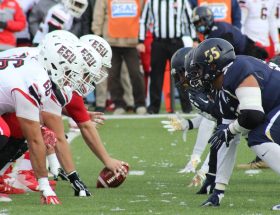In this article, we delve into the dynamic and exciting world of sports in New Zealand. From the nation’s beloved rugby and cricket teams to lesser-known but equally thrilling activities such as surfing and extreme sports, we take a closer look at the diverse range of sports that Kiwis enjoy. Additionally, we examine the cultural significance of sports in New Zealand and how it shapes the national identity. Whether you’re a sports enthusiast or simply curious about the sports scene in New Zealand, this article is sure to be an insightful and informative read.
 Running is a great way to stay healthy and active, but it’s important to choose the right shoes to prevent injury and ensure maximum comfort. With so many options available on the market, it can be overwhelming to choose the perfect pair of running shoes. In this guide, we’ll walk you through the key factors to consider when choosing the right running shoes for your feet.
Running is a great way to stay healthy and active, but it’s important to choose the right shoes to prevent injury and ensure maximum comfort. With so many options available on the market, it can be overwhelming to choose the perfect pair of running shoes. In this guide, we’ll walk you through the key factors to consider when choosing the right running shoes for your feet.
The Importance of Choosing the Right Running Shoes
Wearing the right running shoes is critical for a comfortable and safe running experience. Ill-fitting shoes can cause discomfort, blisters, and even injuries such as shin splints or stress fractures. When choosing running shoes, there are several factors to consider to ensure that you select the best pair for your needs.
Factors to Consider When Choosing Running Shoes
1. Foot Type and Arch
The first step to choosing the right running shoes is to consider your foot type and arch. There are three types of foot arches: high, normal, and flat. Understanding your foot arch can help you find the right level of support and cushioning. Flat feet may require shoes with more support, while high arches may require shoes with extra cushioning.
How to Determine Your Foot Arch Type
One way to determine your foot arch type is to perform the wet test. Wet your feet and step onto a piece of paper or cardboard. The shape of the footprint can help you determine your arch type. A flat arch will result in a full footprint, while a high arch will show only a thin strip connecting the heel and the ball of the foot.
2. Running Surface
The surface you run on can also impact the type of shoe you should choose. Trail runners may require shoes with more grip and stability, while road runners may require shoes with more cushioning.
3. Foot Strike
Foot strike refers to the way your foot lands on the ground when you run. There are three types of foot strikes: heel, midfoot, and forefoot. The type of foot strike can impact the type of shoe you need. Heel strikers may require shoes with more cushioning, while midfoot or forefoot strikers may require shoes with less cushioning.
4. Shoe Size and Fit
Ensuring that your shoes fit properly is critical for preventing injuries and maximizing comfort. Be sure to measure your feet before purchasing shoes and choose a size that allows for a thumb’s width of space between your toes and the end of the shoe.
Types of Running Shoes
There are several types of running shoes available, each with their own features and benefits. Here are the most common types of running shoes:
1. Neutral Shoes
Neutral shoes are designed for runners with normal arches and a neutral foot strike. These shoes provide a good balance of cushioning and support.
2. Stability Shoes
Stability shoes are designed for runners with mild to moderate overpronation, which is when the foot rolls inward too much during a stride. These shoes provide extra support and cushioning to help correct overpronation.
3. Motion Control Shoes
Motion control shoes are designed for runners with severe overpronation. These shoes provide extra stability and control to help prevent injury.
4. Minimalist Shoes
Minimalist shoes are designed to mimic barefoot running by providing a natural feel and minimal support. They are lightweight and have a low heel-to-toe drop, which can help improve running form and strengthen the feet and legs. However, they are not suitable for everyone and should be transitioned to slowly to avoid injury.
Additional Features to Consider
In addition to the factors mentioned above, there are several additional features to consider when choosing the right running shoes. These include:
1. Cushioning
Cushioning is the amount of padding in the sole of the shoe. More cushioning can provide greater shock absorption and comfort, but can also add weight to the shoe.
2. Breathability
Breathable shoes allow for airflow and can help keep feet cool and dry during runs. This is especially important for runners who sweat heavily.
3. Durability
The durability of a shoe refers to how long it will last before it wears out. Consider the materials used in the shoe and the expected lifespan before making a purchase.
4. Flexibility
The flexibility of a shoe refers to how easily it bends and moves with the foot. More flexible shoes can help improve running form and reduce the risk of injury.
Where to Buy Running Shoes
When purchasing running shoes, it’s important to buy from a reputable retailer that specializes in athletic footwear. This ensures that you receive expert advice and can try on a variety of shoes before making a purchase. Some popular retailers for running shoes include:
Road Runner Sports
Fleet Feet
JackRabbit
REI
Dick’s Sporting Goods
Conclusion
Choosing the right running shoes is essential for a comfortable and safe running experience. Consider your foot type, running surface, foot strike, shoe size and fit, and additional features such as cushioning, breathability, durability, and flexibility when making a purchase. By selecting the right running shoes, you can help prevent injury and improve your overall running performance.









